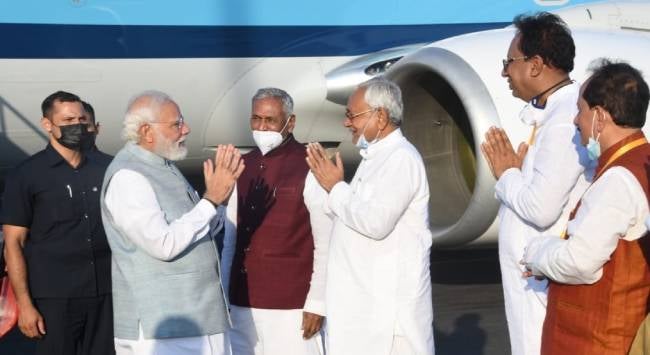Summary
The latest events in Bihar in India saw Chief Minister Nitish Kumar pull out from his alliance with the Bharatiya Janata Party and join hands with the Rashtriya Janata Dal. The realignment in Bihar could have an impact on state and national politics.
The dust has settled for the time being in the eastern Indian state of Bihar with Chief Minister Nitish Kumar winning the vote of confidence in the State Assembly on 24 August 2022. The exit of Nitish and his party, the Janata Dal (United) [JD(U)], from its alliance with the Bharatiya Janata Party (BJP) and successful formation of a government with the Rashtriya Janata Dal (RJD) is a rare instance where the BJP has lost power in a state. It also has ramifications for opposition politics and the 2024 general elections.
Nitish’s outmanoeuvring of the BJP stands out since it is the BJP that has been successful in toppling opposition governments one after the other in the states, the latest being in Maharashtra earlier this year. The following are some important takeaways from the events in Bihar.
First, Nitish has shown once again that he is the consummate political survivor, knowing just when to strike an alliance or leave one. Nitish, who was sworn in as Bihar Chief Minister on 10 August 2022, has changed sides to stay in power on at least five occasions. The last time was in 2017, when he deserted an alliance with the RJD and the Congress, and tied up with the BJP, prompting the RJD chief Lalu Prasad Yadav to label him ‘Paltu Ram’ (a turncoat). Five years later, Nitish is back with the RJD, now led by Lalu’s son, Tejashwi Yadav.
Second, the BJP, which has been adept at engineering defections in opposition-ruled states, has been stymied for once. While there had been tension between the BJP and JD(U) over a range of issues, including making the caste census public and the special category status for Bihar, Nitish preempted the BJP by quitting the alliance. There had even been talk of doing a ‘Shinde’ on Nitish, a reference to what had happened in Maharashtra, where a large number of Shiv Sena members of the state legislative assemblies (MLAs, led by Eknath Shinde, left the party, resulting in the fall of the Maha Vikas Aghadi government. When Nitish’s confidante and colleague, R C P Singh, quit the JD(U) to join the BJP in early August 2008, there was a buzz that he might take some MLAs along with him and split the party.
However, Nitish not only managed to stave off the BJP threat, but also struck a new alliance.
That Nitish could do so was partly due to the opposition numbers that were against the BJP. The combined strength of the JD(U), the RJD, the Congress and other smaller parties is 162 seats in the Bihar Assembly, whose current strength is 242 seats. So, for the BJP, which has 77 MLAs, it would have been a tall order to wean sufficient numbers from the JD(U) and the other parties to reach the majority mark. The BJP’s central leadership realised the futility of the task and decided not to play the game of defections.
Third, for the RJD, this is an opportunity to be part of the government, and for Tejashwi, who has been appointed Deputy Chief Minister, to display his administrative acumen. The RJD, under the leadership of Tejashwi, had done remarkably well in the 2020 Bihar Assembly elections, winning 75 seats. However, it did not have the numbers to form the government. Now, the alliance with the JD(U) gives Tejashwi the chance to cement his credentials and grow out of his father’s shadow.
The political realignment in Bihar could significantly impact the 2024 general elections. The RJD-JD(U) combination is a formidable one with a voter base of Yadavs, Muslims and Kurmi-Koeris that constitutes nearly 40 per cent of Bihar’s electorate. This is considerably more than the BJP’s committed voter base of upper castes, along with a share of Extremely Backward Classes and Dalits. However, politics is more than just electoral mathematics and how much of a vote transfer happens between the RJD and JD(U) at the constituency level will be critical to their fortunes. Two years is also a long time in Indian politics, and it remains to be seen if the RJD and JD(U) will remain partners in 2024.
At the national level, the RJD-JD(U) government in Bihar will provide hope to the opposition that the BJP can be beaten at its own game. However, the implications of the realignment might not be felt outside Bihar, where the political equations are different. Nitish could also position himself as a prime ministerial aspirant in 2024, but it is likely to be a crowded field. There are several aspirants from the opposition for the prime minister’s chair, including the Congress’s Rahul Gandhi, the Aam Aadmi Party’s Arvind Kejriwal and Trinamul Congress’s Mamata Banerjee. Besides, Nitish has lost some credibility due to his many political turnarounds, including the latest one.
. . . . .
Dr Ronojoy Sen is a Senior Research Fellow and Research Lead (Politics, Society and Governance) at the Institute of South Asian Studies (ISAS), an autonomous research institute at the National University of Singapore (NUS). He can be contacted at isasrs@nus.edu.sg. The author bears full responsibility for the facts cited and opinions expressed in this paper.
Pic Credit: Nitish Kumar’s official Twitter account
-
 More From :
More From :
-
 Tags :
Tags :
-
 Download PDF
Download PDF



